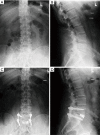Minimally invasive transforaminal lumbar interbody fusion with expandable articulating interbody spacers significantly improves radiographic outcomes compared to static interbody spacers
- PMID: 34734134
- PMCID: PMC8511571
- DOI: 10.21037/jss-20-630
Minimally invasive transforaminal lumbar interbody fusion with expandable articulating interbody spacers significantly improves radiographic outcomes compared to static interbody spacers
Abstract
Background: The goal of minimally invasive transforaminal lumbar interbody fusion (MI TLIF) is to restore and maintain disc height and lordosis until arthrodesis occurs, while minimizing muscle disruption and improving recovery time. The purpose of this study was to compare the radiographic outcomes in patients treated with an articulating expandable spacer in MI TLIF to more traditional static spacers.
Methods: This was a multi-site, multi-surgeon, Institutional Review Board-exempt, retrospective clinical study from a prospectively collected database. It included 48 patients with a diagnosis of degenerative disc disease (DDD) at one level from L2 to S1 with or without Grade 1 spondylolisthesis who underwent MI TLIF using either an articulating expandable or static interbody spacer. Twenty-seven patients were in the banana-shaped articulating expandable interbody spacer (ALTERA®, Globus Medical, Inc., Audubon, PA, USA) group, while 21 patients were in the static interbody spacer group. Both groups had supplemental posterior pedicle screw and rod fixation. Radiographic records were assessed for disc height, neuroforaminal height, and lordosis at baseline, 3 and 6 months, and final follow-up.
Results: The articulating expandable spacer group displayed significantly greater improvement in anterior disc height from baseline compared to the static spacer group at 6 weeks, 3 and 6 months, and final follow-up by averages of 2.6 mm (79%), 2.8 mm (92%), 3.4 mm (105%), and 3.8 mm (139%), respectively (P<0.05). Mean increases in posterior disc height were significantly greater in the expandable group compared to the static group by 1.2 mm (65%) and 1.7 mm (104%) at 6 months and final follow-up, respectively (P<0.05). Articulating expandable spacers produced significantly greater average improvement by 4.0 mm in neuroforaminal height from baseline to final follow-up compared to static spacers (P<0.05). Increases in intervertebral angle from baseline were significantly greater in the expandable group than in the static group at 3 and 6 months, and final follow-up by averages of 2.5°, 2.8°, and 3.1°, respectively (P<0.05). The articulating expandable spacer group resulted in significantly greater improvements in lumbar lordosis from baseline to 3 and 6 months than the static spacer group by 4.4° and 4.0°, respectively (P<0.05).
Conclusions: MI TLIF with articulating expandable interbody spacers provides significant restoration and maintenance of disc height, neuroforaminal height, and lordosis compared to static spacers in this comparative cohort. Long-term clinical outcomes are needed to correlate with these radiographic improvements.
Keywords: Minimally invasive; arthrodesis; lordosis; static; transforaminal lumbar interbody fusion (TLIF).
2021 Journal of Spine Surgery. All rights reserved.
Conflict of interest statement
Conflicts of Interest: All authors have completed the ICMJE uniform disclosure form (available at https://dx.doi.org/10.21037/jss-20-630). Dr. AJR reports personal fees from Globus Medical, Inc., during the conduct of the study; personal fees from Orthofix, personal fees from Surgentec, outside the submitted work; Dr. SAS reports personal fees from Globus Medical, Inc., during the conduct of the study; personal fees from RTI Surgical, personal fees from Organogenesis, from Arthrex, outside the submitted work; Mr. TS reports personal fees from Globus Medical, Inc., during the conduct of the study. The other authors have no conflicts of interest to declare.
Figures




References
LinkOut - more resources
Full Text Sources
Research Materials
